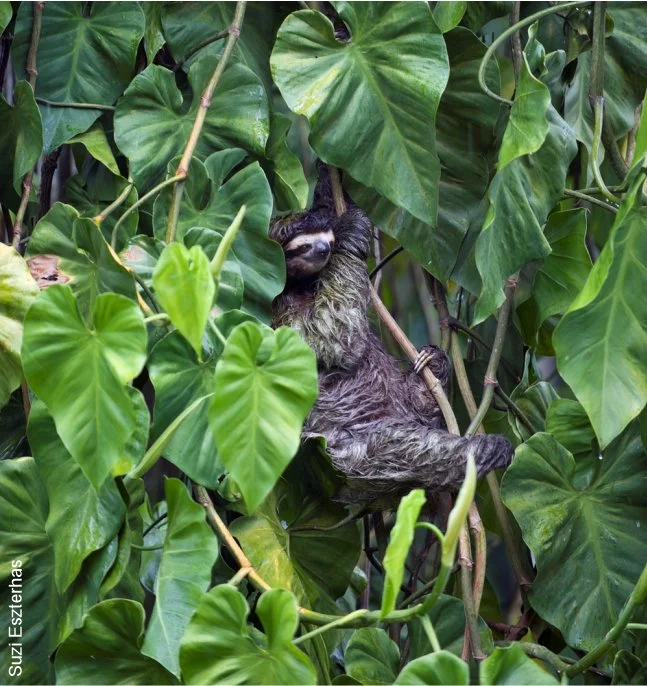2024 | Climate Change Threatens the Future of Sloths
Our latest research, “Sloth metabolism may make survival untenable under climate change scenarios,” led by Dr. Cliffe, has been published in PeerJ and explores a possible future for sloths and their survival in a world that is getting hotter.
Depending On Ambient Temperature To Live
The resting metabolic rate (RMR—the amount of energy expended by an organism to run vital processes while at rest in a neutrally temperate environment) of sloths is unusually low compared to other mammals, but this helps them conserve energy (which is a resource they do not have much of!).
Two-fingered sloth sleeping in the canopy
This low metabolic rate allows sloths to survive on a low-calorie diet, but it also makes them highly sensitive to changes in ambient temperature, as their ability to regulate body temperature and energy use is limited.
Previous research published by Dr. Cliffe shows how ambient temperature affects the food intake of three-fingered sloths (they eat more when it’s hotter, unlike other mammals) and how the metabolic rates of sloths respond to ambient temperature.
Read More: Sloths Like It Hot: Food Intake of Three-Fingered Sloths
The research
The research used indirect calorimetry to measure the oxygen consumption, along with the body temperature and body posture of sloths when exposed to a range of different ambient temperatures (18°C to 34°C) over several days to determine their metabolic rates.
Sloth in a tropical rainforest / Photo: Suzi Eszterhas
The sloths in this study were two-fingered sloths (Choloepus hoffmanni) that lived in a rescue center for less than 18 months. The sloths were rescued and unable to be released back into the wild, but they were all healthy.
Sloths from the highlands
The sloths came from the lowlands of the South Caribbean of Costa Rica and from the highlands of the country. The highlands in Costa Rica are typically 3-9°C cooler than the corresponding lowland forests, and this difference is important in the study.
This graphic is from previous research on sloth genetics and the potential impact of relocating rescued sloths to inappropriate areas.
High-altitude Choloepus sloths have longer, thicker, and darker fur, presumably to adapt better to the colder conditions, and they also maintain an overall higher RMR (Resting Metabolic Rate) than their lowland counterparts.
The results: Sloth metabolism may make survival untenable under climate change scenarios.
The researchers found that when temperatures rise above a certain point, sloths from low-altitude areas are able to slow down their metabolism even further to cope with the heat. This is a survival mechanism that helps them conserve energy and avoid overheating.
Sloths from high-altitude regions, however, do not have this ability. Instead, their metabolism actually speeds up as temperatures rise, leading to a higher body temperature and thus spending more energy.
As the climate continues to warm, high-altitude sloths may not be able to adapt quickly enough: their bodies will require more energy to keep functioning, but sloths already have a limited ability to take in and process food. High-altitude sloths might not survive in a warmer world.
The lowland sloths are not safe either
Sloths in low-altitude regions might already be used to warmer temperatures and might be better equipped to handle the rising temperatures, but they will be affected as well: as their habitats become hotter and possibly drier, food and water can become more scarce.
Sloth wearing a tracking collar in the South Caribbean of Costa Rica
Climate change is a direct and indirect threat to sloths, ecosystems, and ultimately to humans. And although it’s often easier to imagine the end of the world than a change in the system, we can take simple steps as individuals to mitigate the effects of climate change: recycling and reusing, eating greener, and reducing the amount of stuff we buy to combat overconsumption.
However, big corporations and governments, especially those in the global north, must also be held accountable and take their responsibility seriously. They hold the power to implement large-scale solutions that can slow down and eventually reverse the damage to the environment worldwide.








